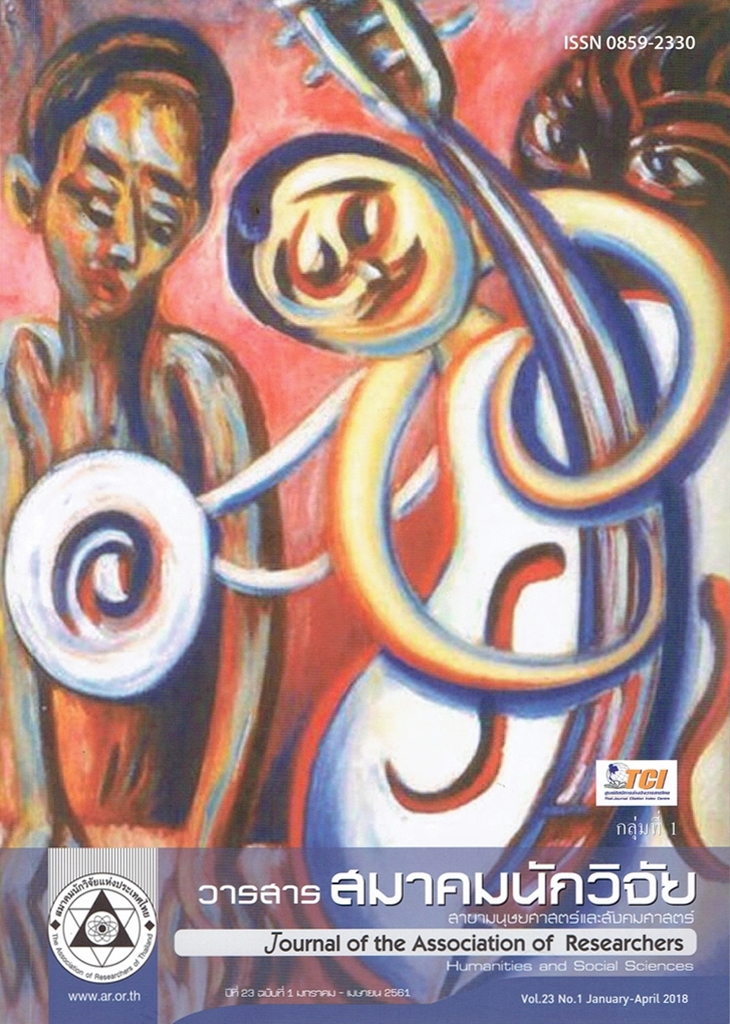Structural Equation Model of Causal Factors Affecting the Success of Steel Industry Operators in the Age of Thailand 4.0
Main Article Content
Abstract
The objectives of this study are to examine the correspondence of structural equation model of causal factors affecting the success of steel industry operators in the age of Thailand 4.0, and to develop structural equation model of causal factors affecting the success of steel industry operators in the age of Thailand 4.0. The indicators were derived from literature review and relevant research studies. The data were collected from a sample of 400 top-executive operators or their representatives. The instrument used for measurement was a questionnaire with five-point scale, and the data were analyzed using structural equation modeling. It was found that structural equation model of causal factors affecting the success of steel industry operators in the age of Thailand 4.0 corresponded to the literature and empirical data, where p-value =0.101, GFI = 0.975, CFI = 0.937, NFI = 0.973, IFI = 0.942, RMSEA = 0.025, and SRMR =0.023, which met the criteria set for the results of variable analysis in the newly developed model. When the total effect of the model was considered, it was found that proactive operation, product innovation, and process innovation had a significant direct effect on the success of business operator performance. Product innovation operation had the highest effect (TE=0.52), followed by Proactive (TE=0.30), and process innovation (TE=0.19), respectively. In addition, proactive operation had an indirect effect through product innovation (IE=0.49) and process innovation (IE=0.16).
Article Details
บทความที่ปรากฏในวารสารนี้ เป็นความรับผิดชอบของผู้เขียน ซึ่งสมาคมนักวิจัยไม่จำเป็นต้องเห็นด้วยเสมอไป การนำเสนอผลงานวิจัยและบทความในวารสารนี้ไปเผยแพร่สามารถกระทำได้ โดยระบุแหล่งอ้างอิงจาก "วารสารสมาคมนักวิจัย"
References
ฐานเศรษฐกิจ. (2559). ธุรกิจเหล็กในไทยมีแนวโน้มฟื้นตัวอานิสงส์จากโครงการก่อสร้างและเหล็กเกรดพิเศษเติบโต. ค้น เมื่อ 1 มกราคม 2560, จาก http://www.thansettakij.com
วิภาวดี ศรีโสภา. (2558). มองอนาคตและผลกระทบจากภาวะเหล็กจีนล้นตลาด. ค้นเมื่อ 1 มกราคม 2560 , จาก http:// www.prachachat.net/news_detail.php?newsid=1436344640.
สุชาติ ประสิทธิ์รัฐสินธุ์. (2551). เทคนิคการวิเคราะห์ตัวแปรหลายตัวสำหรับการวิจัยทางสังคมศาสตร์และพฤติกรรมศาสตร์. พิมพ์ครั้งที่ 6. กรุงเทพมหานคร. ห้างหุ้นส่วนจำกัดสามลดา
References
Avlonitis, G. J. et al. (1994). Innovativeness of Organizations and its Antecedents: Project Innovastrat European Journal of Marketing. 28(11), 5-28.
Beukes, C., & van Wyk, G. (2016). An investigation of the marketing performance measurement practices in hatfield volkswagen group. African Journal of Business Management, 10(6), 131-139.
Cambra-Fierro, J., Hart, S., Mur, A. F., & Redondo, Y. P. (2011). Looking for performance: How innovation and strategy may affect market orientation models. Innovation : Management, Policy & Practice. 13(2), 154-172.
Dess, G. G. & Miller, A. (1993). Strategic Management. (Int’l Ed.). Singapore: Mc Graw. Dess, G. G., Lumpkin, G. T., & Eisner, A. B. (2007). Strategic management creating competitive advantage. Boston: McGraw-Hill.
Diamantopoulos, A., & Siguaw, J. A. (2000). Introducing LISREL. London: Sage.
Duangruodee Semaphu1, Norapol Chinuntdej and Prayong Meechaisue. (2017). The Influence of Participatory Administration on the Work Performance of Employees at Commercail Banks in Thailand. Journal of the Association of Researchers. 22 (1), 27-40. (in Thai).
Gomez, J., Llonch, J., & Rialp, J. (2011). Strategic Orientation, Innovation and Performance of new SMEs. GSTF Business Review (GBR). 1(2), 76-79.
Gross, R. (2016). The impact of leadership styles on employee entrepreneurial orientation and innovative behavior: A comparative analysis of american and indian immigrant entrepreneurs. Available from ProQuest Dissertations & Theses Global.
Hair, J. F., Black, W. C., Babin, B. J., Anderson, R.E., & Tatham, R. L. (2006). Multivariate Data Analysis. NJ:Pearson.
Kiwan, S. M. (2013). The moderating role of environmental dynamism in the relation between entrepreneurial orientation and firm performance: An empirical study on food industry in northern west bank. Available from ProQuest Dissertations & Theses Global.
Kohli, A.K. Jaworski, B.J. and Kumar, A. (1993). Markor: A measure of market orientation. Journal of Marketing Research. 30(4), 467-477.
Kosol Jitvirut and Neugpunna Yaviraj. (2016). A Confirmatory Factor Analysis of Factors Influencing the Competitiveness of Rubber Gross Industry Entrepreneurs under Conditions of Dynamic Change. Journal of the Association of Researchers. 21 (1), 154-165. (in Thai).
Kotler, Philip and Armstrong, G. (2010). Principles of Marketing.
Pearson. Kumar, K. (2010). Similarities and differences in the strategic orientation, innovation patterns and performance of SMEs and large companies. The Business Review, Cambridge, 16(2), 50-56.
Kwak H, Jaju A, Puzakova M, Rocereto J. (2013). The Connubial Relationship between Market Orientation and Entrepreneurial Orientation. Journal of Marketing Theory and Practice. 21(2), 141–161.
Lee, S., & Peterson, S. (2000). Culture, entrepreneurial orientation and global competitiveness. Journal of World Business, 35(4), 401-416.
Li, Z. Z. (2010). Study on relationship among social capital,entrepreneurial orientation and performance based on the corporate entrepreneurship of tech-typed smes. Available from ProQuest Dissertations & Theses Global.
Lyon, D., Lumpkin, G. and Dess, G. (2000). Enhancing Entrepreneurial Orientation Research : Operationalizing and Measuring a Key Strategic Decision-Making Process. Journal of Management, 26(5),1055-85.
Miller, D. (1983). The correlates of entrepreneurship in three types of firms. Management Science, 29(7), 770-791.
Ministry of industry. (2016). Thailand Industry Development Strategy 4.0 for 20 years (2017-2036). Retrieved 16 January 2017, form http://www.oie.go.th/sites/default/files/attachments/industry_ plan/thailandindustrialdevelopmentstrategy4.0.pdf. (in Thai).
Moghaddam, A. G., Imani, Y. A., Erteza, N., & Setayeshi, L. (2013). Mediating role of innovation & marketorientation in the relationship between knowledge management & financial performance: A case study of small & enterprereur busuness. Interdisciplinary Journal of Contemporary Research in Business, 5(3), 688-697.
Mullens, D. S. (2013). TMT characteristics that position family firms for success: Examining the effects of human capital, non-familiness, entrepreneurial orientation, and transactive memory systems. Available from ProQuest Dissertations & Theses Global.
Narver, J. C., & Slater, S. F. (1990). The effect of a market orientation on business profitability. Journal of marketing, 54(4), 20-35. Nelson Oly Ndubisi,
James Agarwal. (2014). Quality performance of SMEs in a developing economy: Direct and indirect effects of service innovation and entrepreneurial orientation. Journal of Business & Industrial Marketing, 29(6), 454 - 468
Nilawan Sawangrat. (2015). The Structural Effects of Entrepreneurship, Market Orientation, Innovation Orientation, and Learning Orientation on Firm Performance. Veridian E-Journal, Silpakorn University 8(3), 957-975. (in Thai).
North, D., & Smallbone, D. (2000). The innovativeness and growth of rural SMEs during the1990s. Regional Studies, 34(2), 145-57.


